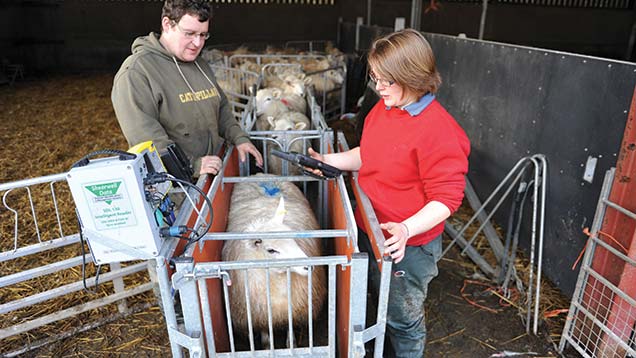Earlier lamb weaning slashes costs for Welsh flock

Weaning lambs a month earlier is one of a series of changes that has enhanced the performance of a Welsh lowland flock.
Ben Anthony and Diana Fairclough run 700 ewes and ewe lambs and a suckler herd at 59ha Frowen Farm, near Whitland, Carmarthenshire. The couple also farm 44ha of rented land.
Through their work as a Farming Connect Demonstration Farm, they ran a trial this year investigating the impact of weaning lambs at the end of June, a month earlier than in 2013.
They had used teaser rams to condense the lambing period to two months, from the beginning of March, instead of their previous pattern of lambing over three months from February.
This approach resulted in 500 lambs born within 17 days. In 2013 it took 32 days to reach this point and 44 days in 2012. Lambs were also more uniform in size at drenching and weaning.
See also: Tough action needed against sheep farmers not tackling scab
The couple then weaned a month earlier and lamb growth rates and sales in July rocketed. Within a month of weaning 212 lambs were sold compared with 135 during the same period the previous year.
This has helped to lower production costs at Frowen Farm and is a policy the couple will continue.
“We were concerned about weaning early, but put our faith in the advice we received from [independent expert] Lesley Stubbings and have seen several benefits, including improved daily liveweight gains and an ability to better utilise our improved pastures for the lambs.
“The ewes have also had extra time to gain condition ready for autumn tupping,” says Mr Fairclough.
Sheep consultant Ms Stubbings says finishing lambs earlier not only reduces costs, but enables a farm to carry more ewes.
“If lambs can be sold earlier, they cost less per kilo to produce. For every additional day a lamb is on the farm it costs money because every mouthful of grass costs something,” she says. “If lambs are not hanging around on the farm into the winter it might be possible to carry more ewes.”
Lamb losses at Frowen were much lower also thanks to the introduction of an abortion vaccination programme and improved ewe nutrition in late pregnancy.
“Last year we had problems with enzootic abortion and toxoplasmosis so we vaccinated all the yearlings and ewe lambs. From now on we will vaccinate the ewe lambs annually,” he says.
By feeding a 21% protein concentrate matched to silage quality, feed cost per ewe reduced to £4.91, from £15.75 in 2013 and £11.03 in 2012. This allowed the potential of the silage to be fully utilised. The concentrate was introduced at different times and in varied quantities, depending on how many lambs ewes were carrying.
The cost of the concentrate was £16/t – more costly than the 18% concentrate normally used at Frowen – but much less was fed. Ewes expecting twins received 400g a day compared with 800g in 2013.
“Another reason for the reduced amount of concentrates being used was that all the ewes lambed in a short period reducing the housing time and were turned out to grass so concentrate feeding could be stopped sooner,” says Mr Fairclough.
There has been a focus on pasture quality and grazing too, through growing brassicas as a break crop then reseeding with high quality leys. Lambs were finished on red clover, on a rotational grazing system.
“It is not strict rotational grazing but by moving the lambs regularly they did well, and we are now hoping to set up a rotational grazing system for next year to utilise our grass more efficiently,” he explains.
All ewe lamb replacements are bought-in – this year 179 Aberfield cross ewe lambs were purchased. “Previously we were producing fat lambs and retaining our own ewe lambs but we decided to concentrate our efforts on producing fat lambs by using all terminal sires,” says Mrs Fairclough.
The influence of shearing on lamb performance has also been investigated.The trial involved shearing 95 ewe and wether lambs in mid-July while a further 95 were left unshorn.
The trial demonstrated that shearing had very little impact on average growth rates – both shorn and unshorn lambs grew at the same rate after shearing and while the weights at which the shorn lambs were sold was 0.65kg heavier they were on farm an average of eight days longer.
Stay connected
Farming Connect is a Wales-wide service funded by the Rural Development Programme and the Welsh government.
As part of an ongoing series, Farmers Weekly will be visiting a different Farming Connect demonstration farm regularly to find out what projects have been undertaken and how performance is benefiting.

